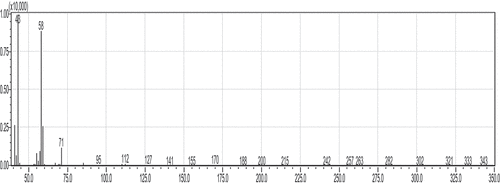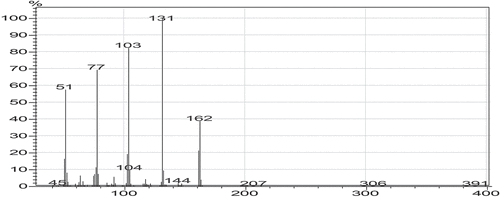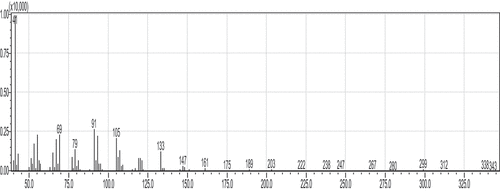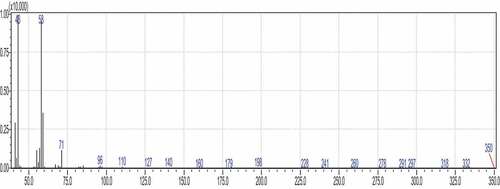ABSTRACT
Variation in the composition of leaf essential oils of Zanthoxylum armatum in relation to altitude and soil chemistry was analyzed in Nepal. The essential oil was extracted by Clevenger apparatus and the components were analyzed through GC-MS. The results showed that: Yield of the essential oil obtained from the hydro-distillation of dried leaves ranged from 0.16% to 0.50%. GC-MS analysis revealed total of 17 compounds in the essential oil from the dried leaves of Z. armatum from different altitudes and populations (wild and cultivated). The three major components, linalool, limonene and undecan-2-one, present in higher proportion in all the samples were analyzed. Other components tridecan-2-one, myrcene, cinnamate(E)-methyl and alpha-bergamotene were also identified in most of the samples but in lower proportions. The highest number of components (12) was identified from the wild samples collected from 1990 m and the lowest number (7) was from 1060 m (wild) and 2030 m (cultivated populations). Linalool, a major component was found in higher amount (64.88%) at the lowest altitude of 1060 m. Results of the present study showed that the altitude, soil chemistry, and growing conditions significantly affect the essential oil components in Zanthoxylum armatum.
Introduction
Among the eight species of Zanthoxylum (family Rutaceae) reported from Nepal so far, Zanthoxylum armatum, commonly called as Timur is one of the important medicinal and aromatic plants. It is a small aromatic tree or large shrub up to 6 m high and found in the hot valleys of Himalayas (Kashmir to Bhutan), north-east India, Nepal, Pakistan, Laos, Myanmar, Thailand, China, Bangladesh, Bhutan, and Japan.[Citation1] In Nepal, it is distributed from west to east at an elevation range of 1000 m to 2500 m in open places or in forest undergrowth.[Citation2] The plant is highly valued because of its medicinal, phytochemical and pharmacological properties and has been used in different traditional medicinal practices as carminative, antipyretic, appetizer, anthelmintic, stomachic, toothache, dyspepsia.[Citation3–Citation5]
Although all the parts of the plants possess essential oil, the fruits (pericarp) essential oil, commonly known as Zanthoxylum oil is highly valued for commercial purpose. Several studies have been carried out on the essential oil composition of the fruits, seeds, and leaves of Zanthoxylum armatum, which reveal that the main constituents of the oil are linalool and limonene.[Citation6–Citation8] Besides, several other compounds like myrcene, camphene, oleic acid, palmitic acid, methyl ester alpha- and beta-pinene, trans-beta-ocimene have also been identified from the volatile oil.[Citation6,Citation9–Citation12] Similarly, several monoterpenes have also been identified from the leaves and the major ones are linalool, limonene cymene, myrcene, geraniol carvone, tridecanone, trans-caryophyllene, terpinolene, ocimene. One study claimed that 2-undecanone was identified as the major component of the leaf essential oil of Z. armatum for the first time from Kumaun, India.[Citation13]
The accumulation of active substances in plants may be affected by several factors like the age of the plant, season, solar radiation, altitude, nutritional status, climatic and edaphic factors.[Citation14,Citation15] Several researches have proved that the different ecological, physiological, and genetic factors also affect the quality and quantity of secondary metabolites as well as their biological activities.[Citation16–Citation18] Among them, altitude, precipitation, soil texture, soil diversity, organic matters’ rate, calcium phosphorus, and potassium elements are the most effective factors influencing the essential oil components.[Citation19,Citation20] Among all these factors, the most discussed one is the higher solar intensity at higher altitudes that has significant impact on secondary metabolite composition in higher plants.[Citation21]
Literature shows that numerous works have been conducted on the composition of essential oil in Z. armatum, most of them on the fruit and very few on the leaf.[Citation22] So far, no comprehensive study has been performed on the interrelationship between elevation and edaphic factors and the chemical composition of leaf essential oil in Z. armatum collected from different elevations and populations. Hence, this study endeavors to establish a linkage between the altitude, soil characters of the habitat and the constituents of the leaf essential oil of Z. armatum, the result of which could be of relative significance in providing new insights for future studies to find out the high yielding desired components of the essential oil.
Methods
Collection of leaves
The required samples were collected from Salyan district of Nepal during May 2018. The location was chosen for this study as Timur, is the main non-timber forest product (NTFP) of this district accounting to approximately 70% of the total value of the NTFPs collected.[Citation23] Further, the government of Nepal has also prioritized the district for the commercial cultivation and facilitation of Timur.
Sampling was done during May 2018 and systematic random sampling method was applied to collect the leaves. Healthy and vigorous plants were selected from different populations (wild and cultivated) and altitudes ranging from 1000 m to 2030 m and fresh leaves of Zanthoxylum armatum were collected. The leaves were shade dried for a week before extraction of the oil. Herbarium of voucher specimens were prepared, and deposited at National Herbarium and Plant Laboratories (KATH) NPZA 20-NPZA 50. The details of the locality are presented in .
Table 1. Locality details
Collection and analysis of soil samples
While collecting the leaf samples, soil samples from different habitats and altitudes were also collected from a depth of 15–30 cm. Collected samples were brought to the laboratory, air dried and passed through a 2-mm sieve. Soil organic carbon, total N and pH of the soil were determined according to the Walkley and Black, Kjeldahl and potentiometry methods, respectively. Soil analysis was carried out at the laboratory of the Forest Research and Training Centre, Babarmahal, Kathmandu.
Extraction of essential oil
Total of 10 samples have been used for this study. The collected leaves were shade dried at room temperature. For the extraction of the oil, 100 g of the dried leaves were subjected to hydro-distillation for 6 h using modified Clevenger-type apparatus. The protocol was followed according to the British Pharmacopoeia.[Citation24] The volume of the oil was measured directly in the extractor. The oil thus collected was then dehydrated over anhydrous sodium sulfate and stored in sealed, labeled glass vials at 4°C until further analysis. Total yield percentage was calculated as volume (ml) essential oil per 100 g of plant dry matter.
Analysis of essential oil samples by GC-MS
Quantitative analysis of the chemical constituents in the essential oils was carried out using a Shimadzu gas chromatograph (GC 2010) with Rtx-5MS column (25 m×0.25 mm× 0.25 µm). The initial column was maintained at 40°C and the injection temperature was 250°C. Qualitative analysis of the essential oil was further continued in a Shimadzu GCMSQP 2010 Plus. The ion source temperature and the interface temperature were kept at 200°C and 250°C, respectively. One µL of the essential oil diluted with spectroscopic grade hexane (10:1) was injected into the GC inlet maintaining column flow rate of 1mL/min and purge flow 3 mL/min after fixing the split ratio at 120, using Helium as a carrier gas. Detector scanning start time was 4 min and end time was 68 min, mass spectra were scanned from m/z 40–350, with the scanning speed of 666. The oil components were identified by the determination of their retention indices (RI), relative to C8–C32 n-alkane series under identical experimental condition, by comparison with authentic reference compounds as well as with published mass spectra[Citation25–Citation30] and by comparison of mass spectra using the NIST 11 (National Institute of Standards and Technology, Gaithersburg, MD) and FFNSC 1.3 library. The relative percentage of each constituent present in essential oil was calculated according to the area of the chromatographic peaks.
Statistical analysis
In order to compare the significantly different means to test the significant effects of altitude and edaphic factors in the percentage yield and chemical composition of leaf essential oil of Z. armatum, one-way ANOVA method was employed using R software package version 3.6.1.[Citation31]
Results and discussion
Essential oil yield
In the present study, the yield of essential oil from leaves ranged from 0.16% to 0.5% at different altitudes (). The lowest yield was 0.16% at 1400 m altitude in wild population, while the highest was 0.5% at 1680 m altitude in wild population. The values are almost similar for all altitudes and populations. But in the samples of India, the variation in the essential oil yield of Z. armatum leaves ranged from 0.088% to 0.176%.[Citation15] The yield depends on several factors like different environmental conditions, genetic differences or time of collection, season.[Citation32] All the samples for this study were collected at the same period, during the phenological period and were extracted simultaneously so there might not have been significant differences in the dry weight essential oil yield.
Table 2. GC-MS analysis of leaf essential oil of Z. armatum from different elevation & populations
Essential oil composition
The chemical composition of leaf essential oil of Zanthoxylum armatum from different populations and altitudes varied significantly. Altogether 17 components were identified by GC-MS analysis in the oil from various altitudes and localities. All the compounds (excluding the trace components) are presented in . The major components are linalool, limonene, and undecan-2-one (), which were present in the highest percentage in all the samples. Besides, myrcene, methyl (E)- cinnamate, alpha-bergamotene and tridecan-2-one () were also present in most of the samples. Highest number of compounds i.e.,12 were present in sample from wild populations at 1990 m, 11 compounds were present at 1000 m (cultivated) and 1400 m (wild). The least number of compounds, i.e., seven was recorded at 2030 m altitude from cultivated populations and 1060 wild and some compounds like alpha-pinene, 2,3-octanedione, isophytol acetate were detected in lower percentage in only one locality/altitude (). Wild populations had comparatively higher number of components than cultivated populations.
The concentration of linalool was highest in all the samples, with an average value of 38.73% followed by undecan-2-one, 22.75% and limonene, 19.82% (). The major components linalool, limonene, and myrcene were present in higher proportion in the wild populations in most of the samples studied, whereas the components like tridecan-2-one and undecan-2-one were identified in lesser amount in wild samples than cultivated ones. The major component linalool shared the highest percentage at lower altitude; 64.48% in the wild population at 1060 m and 62.77% in the cultivated populations at 1000 m. The total number and percentage of components were comparatively higher in the samples from wild populations than in cultivated populations (). Usually, there are marked phytochemical differences between different taxa than intraspecific variations of a particular taxon at different elevations.[Citation33] Significant variations in the amount of linalool and limonene in the plants of different altitudes were observed in the leaf essential oil of Z. armatum.[Citation34] If variations occur in the same taxon at different altitudes, it might be due to the differences in genetic makeup. Thus, the pronounced variations observed in the chemotypes of leaf essential oil of cultivated and wild populations of Z. armatum might be due to genetic variability, different geographical environment, growth and physiological development of the plant.[Citation35] The differences in chemical composition of the essential oil among different altitudes in the present study may be attributed to adaptation to particular habitats or different growing conditions a result of changing ecological niches.
Figure 1. Composition of leaf essential oil of Zanthoxylum armatum at different altitudes and habitats

Figure 2. Structures of the major components of leaf essential oil of Zanthoxhylum Armatum (A) Linalool (B) Limonene (C) Myrcene (D) Methyl (E) Cinnamate (E) Undecan −2-One (F) Alpha-Bergamotene G Tridecan −2-One
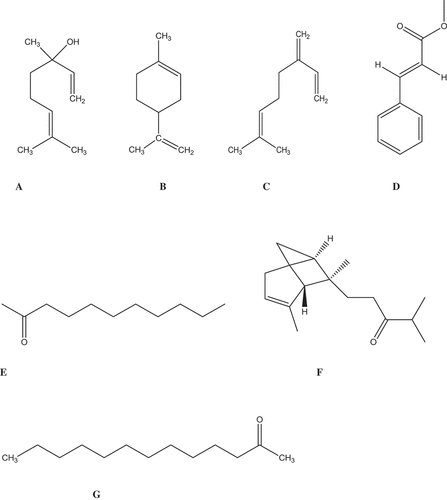
Thirty-four compounds were identified from the leaf essential oil of Z. armatum and the major were beta-Linalool (53.05%), alpha-Limonene diepoxide (11.39%), alpha-pinene (4.08%), beta-Myrcene (3.69%) and D limonene (3.1%).[Citation36] However, compounds like methyl (E)-cinnamate, -alpha-bergamotene and tridecan-2-one, which have been identified as major components in this study were not reported by the previously mentioned study. Also, different components identified in leaf essential oil of Z. armatum by earlier studies have not been detected in the samples used in this study, for e.g., trans-caryophyllene, bornyl acetate, α-copaene[Citation15], sabinene 37, β-fenchol β-phellandrene,[Citation35] etc, indicating wider range of variability in chemotype.
The leaf essential oil of Zanthoxylum alatum of Vietnam constituted major component as 1,8-cineole (41.0%) and others were sabinene (8.4%), b-terpineol (2.1%), linalool (4.5%), terpinen-4-ol (5.2%), a-terpineol (4.1%), b-cymene (1.3%), 2,6-dimethyl-1,3,5,7-octatetraene (1.5%) and 2-tridecanone (1.8%).[Citation37] Fourteen components were identified from the leaf oil of Z. armatum and the major were linalool (30.58%), 2-decanone (20.85%), β-fenchol (9.43%), 2-tridecanone (8.86%), β-phellandrene (5.99%), sabinene (4.82%), and α-pinene (4.11%).[Citation35]
Eco-physiological relations in plants are greatly affected by different environmental factors by solar radiation, temperature, relative humidity, wind velocity, water availability, etc. Altitudinal variations can bring about significant changes in these factors, which in turn affect the secondary metabolites production in plants.[Citation38] Different studies have shown that the harvesting time and season can also have an impact on the yield and the quantitative composition of essential oils components in plants.[Citation39–Citation41] Since all the samples for this study were collected around same time, the effect of harvesting season and time was not applicable in this study.
Soil parameters
Soil chemistry may influence the yield and chemical components of essential oils in aromatic bearing plants.[Citation42] Nitrogen, as one of the important soil minerals, can alter the essential oil component through biosynthetic metabolic pathways.[Citation43] It has been found to increase the essential oil components in some plants like Thyme.[Citation44] The quality and quantity of essential oils of medicinal and aromatic plants may be affected not only by the elevation factors but also by the physicochemical properties of soil.[Citation45] Various chemical elements in soil found in rhizosphere of plants enter into the composition of enzymes and affect the biochemical processes of plants[Citation42]. Hence, the soil chemistry can influence the phytochemical composition.[Citation46]
In the present study, the soil organic carbon, total nitrogen content, and pH of the soil varied among different habitats at different altitudes. Percentage of soil organic carbon was higher in most of the samples from cultivated populations, whereas the total nitrogen content and pH values were slightly higher in most of the wild populations (). The highest total nitrogen (0.656%) was e present in the soil sample from wild population at 1400 m, with neutral soil (pH value 6.78) (). The essential oil yield from the leaves collected from this site was the lowest (0.16%). The lowest value of organic carbon (2.478%) was at present in soil from 1990 m (wild population), where total numbers and percentages of components present were higher. Hence, it can be said that the soil components also have a major role to play in the chemical profiling of the essential oil components.
Table 3. Soil parameters at different altitudes
Result of ANOVA too revealed that different altitudes and soil characters have a significant effect on the essential oil composition and the dry matter yield of Z. armatum. All the major components linalool, limonene, undecan-2-one, tridecan-2-one, myrcene, and alpha-bergamotene were highly significant at P > .01 (). The production of secondary metabolites in plants is directly related to the climatic factors and the quality and quantity of active components is influenced by environmental and genetic factors.
Table 4. ANOVA table for the effect and soil on the major components of Z. armatum essential oil
The unlike distribution of chemicals may be attributed to the different environments of the habitats. The environmental factor favorable for one component might not be suitable for the dominance of another component.[Citation42] For example, in this study also, at the altitude 1060 m, linalool was found in higher amount (64.88%) whereas undecan-2-one in lower proportion (9.55%)
Conclusion
The results of this study showed that variation in elevation, growing conditions, and edaphic factors significantly affect the production and distribution of different active phytochemicals in Zanthoxylum armatum collected from different populations. Among the 17 compounds identified, linalool, undecan-2-one, and limonene were the major constituents of the leaf essential oil, which were more prevalent. Besides, alpha-bergamotene, myrcene, methyl (E)-cinnamate and tridecan-2-one were also identified in almost all the samples. Other components were present in trace amounts. There were distinct variations in the chemical components of the essential oil from wild and cultivated populations. The oil yields as well as the total number and percentage components were also comparatively higher in wild populations than cultivated ones.
Acknowledgments
The first author is thankful to Dabur Nepal for the grant 'Dabur CSR Fellowship (Late Sri Ashok Chand Burman) 01/2016ʹ. We would like to thank Mr. Tara Datt Bhatt, Scientific Officer, Department of Plant Resources for his valuable help in GC-MS analysis. Special thanks to Mr. Mohan Mahato from CIMMYT, Nepal for his assistance in statistical analysis. Mr. Krishna Pun from District Plant Resources Office, Salyan is thankfully acknowledged for his tremendous help during field visit. We also thank Mr. Shamik Mishra, Mr. Kiran Kumar Pokharel and Mr. Prabodh Satyal for their various helps. Sincere thanks to Prof. Dr. Mohan Siwakoti, Head, Central Department of Botany, Tribhuvan University for his encouragement. The authors declare that there is no conflict of interest regarding the publication of this paper.
Additional information
Funding
References
- Nair, K. N.; Nayar, M. P. Rutaceae. In Flora of India. Vol. 4 (Malpighiceae - dichapetalaceae); Hajra, P. K., Nair, V. J., Daniel, P., Eds.; Botanical Survey of India: Calcutta, India, 1997, pp. 179–180.
- DPR. Medicinal Plants of Nepal (Revised edition). Bulletin of Department of Medicinal Plants 28; Department of Plant Resources, Ministry of Forests and Soil Conservation, Government of Nepal, 2007. .
- Manandhar, N. P.;. Plants and People of Nepal; Timber Press, Inc.: Oregon, USA, 2002.
- Kala, C. P.;. Ethnomedicinal Botany of the Apatani in the Eastern Himalayan Region of India. J. Ethnobiol. Ethnomed. 2005, 1(11), 1–8. DOI: 10.1186/1746-4269-1-11.
- Abbasi, A. M.; Khan, M. A.; Zafar, M. Ethno-medicinal Assessment of Selected Wild Edible Fruits and Vegetables of Lesser-Himalayas, Pakistan. Paki. J. Bot. 2013, 45, 215–222.
- Yoshihito, U.; Yuriko, N.; Masayoshi, H.; Shuichi, H.; Seiji, H. Essential Oil Constituents of Fuyu-sanshoo (Zanthoxylum Armatum DC.) In Nepal. Koryo Terupen Oyobi Seiyu Kagakuni Kansuru Toronkai Koen Yoshishu. 2000, 44, 59–61.
- Jain, N.; Srivastava, S. K.; Aggarwal, K. K.; Ramesh, S.; Kumar, S. Essential Oil Composition of Zanthoxylum Alatum Seeds from Northern India. Flavour Fragr. J. 2001, 16, 408–410. DOI: 10.1002/(ISSN)1099-1026.
- Tiwary, M.; Naik, S. N.; Tewary, D. K.; Mittal, P. K.; Yadav, S. Chemical Composition and Larvicidal Activities of the Essential Oil of Zanthoxylum Armatum DC (Rutaceae) against Three Mosquito Vector. J. Vector Borne Dis. 2007, 44(3), 198–204.
- CSIR. A Dictionary of Indian Raw Materials and Industrial Products-Raw Materials Series; Publications and Information Directorate, Council of Scientific and Industrial Research: New Delhi, India, 1976.
- Ramidi, R.; Ali, M.; Velasco-Negueruela, A.; Pérez-Alonso, M. J. Chemical Composition of the Seed Oil of Zanthoxylum Alatum Roxb. J. Essent. Oil Res. 1998, 10(2), 127–130. DOI: 10.1080/10412905.1998.9700862.
- Bachwani, M.; Srivastava, B.; Sharma, V.; Khandelwal, R.; Tomar, L. An Update Review on Zanthoxylum Armatum DC. Am. J. Pharm. Tech. Res. 2012, 2(1), 274–285.
- Bhattacharya, S.; Zaman, K. Essential Oil Composition of Fruits and Leaves of Zanthoxylum Nitidum Grown in Upper Assam Region of India. Pharmacogn. Res. 2009, 1(3), 148–151. http://www.phcogres.com/text.asp?2009/1/3/148/58127
- Bisht, D.; Chanotiya, C. S. 2-undecanone Rich Leaf Essential Oil from Zanthoxylum Armatum. Nat. Prod. Commun. 2011, 6, 111–114.
- Harborne, G.;. Introduction to Ecological Biochemistry; Academic Press: London, 1982.
- Negi, J. S.; Bisht, V. K.; Bhandari, A. K.; Bisht, R.; Kandari, S. Major Constituents, Antioxidant and Antibacterial Activities of Zanthoxylum Armatum DC. Essential Oil. Iran. J. Pharmacol. Ther. 2012, 11, 68–72.
- Mahdavi, M.; Vahid, B. R. The Effects of Ecologic and Habitational Factors on the Essence Quality of Stachys Lavandulifolia Vahl. In North Khorassan Province. Int. J. Farming Allied Sci. 2015, 4(5): 448–456.
- Zhang, N.; Lan, W.; Wang, Q.; Sun, X.; Xie, J. Antibacterial Mechanism of Ginkgo Biloba Leaf Extract When Applied to Shewanella Putrefaciens and Saprophytic Staphylococcus. Aquac. Fish. 2018, 3(4), 163–169. DOI: 10.1016/j.aaf.2018.05.005.
- Geetha, V.; Chakravarthula, S. N. Chemical Composition and Anti-inflammatory Activity of Boswellia Ovalifoliolata Essential Oils from Leaf and Bark. J. For. Res. 2017, 29(2), 373–381. DOI: 10.1007/s11676-017-0457-9.
- Djamshidi, A.; Aminzadeh, M.; Azarnivand, H.; Abedi, M. The Effects of Altitude on Quality and Quantity of Essential Oil in Thymus Kotschyanus L. Iran. Res. J. Aromat. Med. Plants. 2006, 5(18), 17–22. DOI: 10.1186/1746-4269-1-11.
- Tajali, A. A.;. Influence of Ecological Factors on the Chemical Composition of the Essential Oil of Stachys Lavandulifolia (Lamiaceae). Calodema. 2012, 228, 1–4.
- Korner, C. Alpine Plant Life. Functional Plant Ecology of High Mountain Ecosystems; Springer: Berlin, 1999.
- Phuyal, N.; Jha, P. K.; Raturi, P. P.; Rajbhandary, S. Zanthoxylum Armatum DC.: Current Knowledge, Gaps and Opportunities in Nepal. J. Ethnopharmacol. 2019, 229, 326–341. DOI: 10.1016/j.jep.2018.08.010.
- Hertog, W.; Wiersum, K. Timur (Zanthoxylum armatum) Production in Nepal. Mt. Res. Dev. 2000, 20(2), 136–145. DOI: 10.1659/0276-4741(2000)020[0136:TZAPIN]2.0.CO;2.
- British Pharmacopoeia; London: HMSO ed, 1988; Vol. 2, pp. 137–138.
- Adams, R. P.;. Identification of Essential Oil Components by Gas Chromatography/Mass Spectrometry, 4th ed.; Allured Publishing Corp.: Carol Stream, Illinois, USA, 2007.
- Venkateshwarlu, G.; Let, M. B.; Meyer, A. S.; Jacobsen, C. Chemical and Olfactometric Characterization of Volatile Flavor Compounds in a Fish Oil Enriched Milk Emulsion. J. Agric. Food Chem. 2004, 52, 311–317. DOI: 10.1021/jf034833v.
- Eri, S.; Khoo, B. K.; Lech, J.; Hartman, T. G. Direct Thermal Desorption-Gas Chromatography and Gas Chromatography-mass Spectrometry Profiling of Hop (Humulus Lupulus L.) Essential Oils in Support of Varietal Characterization. J. Agri. Food Chem. 2000, 48, 1140–1149. DOI: 10.1021/jf9911850.
- Priestap, H. A.; Van, B. C. M.; Di Leo Lira, P.; Coussio, J. D.; Bandoni, A. L. Volatile Constituents of Aristolochia Argentina. Phytochem. 2003, 63, 221–225. DOI: 10.1016/S0031-9422(02)00751-3.
- Srivastava, A. K.; Srivastava, S. K.; Syamsundar, K. V. Volatile Composition of Curcuma Angustifolia Roxb. Rhizome from Central and Southern India. Flavour Fragr. J. 2006, 21(3), 423–426. DOI: 10.1002/ffj.1680.
- Sing, A. S. C.; Smadja, J. Volatile Constituents of Faham (Jumellea Fragrans (Thou.) schltr.). J. Agric. Food Chem. 1992, 40, 642–646. DOI: 10.1021/jf00016a024.
- R Core Team. R: A Language and Environment for Statistical Computing; R Foundation for Statistical Computing: Vienna, Austria, 2019. https://www.R-project.org/
- Rahimmalek, M.; Tabatabaei, B. E.; Etemadi, N.; Goli, S. A.; Arzani, A. H.; Zeinali, H. Essential Oil Variation among and within Six Achillea Species Transferred from Different Ecological Regions in Iran to the Field Conditions. Ind. Crops Prod. 2009, 29, 348–355. DOI: 10.1016/j.indcrop.2008.07.001.
- Zidorn, C.; Schubert, B.; Stuppner, H. Altitudinal Differences in the Contents of Phenolics in Flowering Heads of Three Members of the Tribe Lactuceae (Asteraceae) Occurring as Introduced Species in New Zealand. Biochem. Syst. Ecol. 2005, 33, 855–872. DOI: 10.1016/j.bse.2004.12.027.
- Gupta, S.; Bhaskar, G.; Andola, H. C. Altitudinal Variation in Essential Oil Content in Leaves of Zanthoxylum Alatum Roxb. A High Value Aromatic Tree from Uttarakhand. Res. J. Med. Plant. 2011, 5(3), 348–351. DOI: 10.3923/rjmp.2011.348.351.
- Guleria, S.; Tiku, A. K.; Koul, A.; Gupta, S.; Singh, G.; Razdan, V. K. Antioxidant and Antimicrobial Properties of the Essential Oil and Extracts of Zanthoxylum Alatum Grown in North-western Himalaya. Sci. World J. 2013, 1–9. DOI: 10.1155/2013/790580.
- Barkatullah, M.; Muhammad, N.; Rehman, I.; Rehman, M. U.; Khan, A. Chemical Composition and Biological Screening of Essential Oils of Zanthoxylum Armatum DC Leaves. J. Clin. Toxicol. 2013, 3(5), 1–6. DOI: 10.4172/2161-0495.1000172.
- Luong, N. X.; Hac, V. L.; Dung, N. X. Chemical Composition of the Leaf Oil of Zanthoxylum Alatum Roxb. From Vietnam. J. Essent. Oil Bear. Plants. 2003, 6(3), 179–184. DOI: 10.1080/0972-060X.2003.10643348.
- Sanli, A.; Karadogan, T. Geographical Impact of Essential Oil Composition of Endemic Kundmannia Analitica Hub.Mor. (Apiceae). Afr. J. Tradit. Complement Altern. Med. 2017, 14(1), 131–137. DOI: 10.21010/ajtcam.v14i1.14.
- Sangwan, N. S.; Farooqi, A. H. A.; Shabih, F.; Sangwan, R. S. Regulation of Essential Oil Production in Plants. Plant Growth Regul. 2001, 34(1), 3–21. DOI: 10.1023/A:1013386921596.
- Nezhadali, A.; Nabavi, M.; Rajabian, M.; Akbarpour, M.; Pourali, P.; Amin, F. Chemical Variation of Leaf Essential Oil at Different Stages of Plant Growth and in Vitro Antibacterial Activity of Thymus Vulgaris Lamiaceae, from Iran. Beni-Suef Univ. J. Basic Appl. Sci. 2014, 3, 87–92. DOI: 10.1016/j.bjbas.2014.05.001.
- Reis, E. S.; Pinto, J. E. B. P.; Bertolucci, S. K. V.; Correa, R. M. Seasonal Variation in Essential Oils of Lychnophora Pinaster Mart. J. Essent. Oil Res. 2014. DOI: 10.1080/10412905.2010.9700288.
- Vaiciulyte, V.; Loziene, K.; Taraskevicius, R.; Butkiene, R. Variation of Essential Oil Composition of Thymus Pulegioides in Relation to Soil Chemistry. Ind. Crops Prod. 2016. DOI: 10.1016/j.indcrop.2016.10.052.
- Azizi, K.; Kahrizi, D. Effect of Nitrogen Levels, Plant Density and Climate on Yield and Quality in Cumin (Cuminum cyminum). Asian J. Plant Sci. 2008, 7, 710–716. DOI: 10.3923/ajps.2008.710.716.
- Baranauskiene, R.; Venskutonis, P. R.; Viskelis, P.; Dambrauskiene, E. Influence of Nitrogen Fertilizers on the Yield and Composition of Thyme (Thymus vulgaris). J. Agric. Food Chem. 2003, 51, 7751–7758. DOI: 10.1021/jf0303316.
- Weiss, U.; Edwards, J. M. The Biosynthesis of Aromatic Compounds; John Wiley & sons: New York, 1980.
- Verpoorte, R.; Heijden, R. V. D.; Memelink, J. Engineering the Plant Cell Factory for Secondary Metabolite Production. Transgenic Res. 2000, 9(4–5), 323–343. DOI: 10.1023/A:1008966404981.




